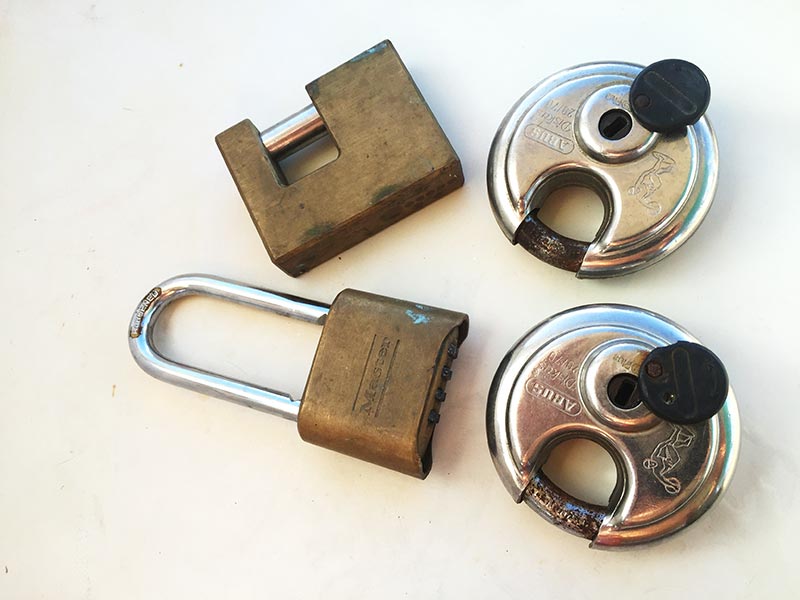Locks: good but not too good!

Lock it or lose it is not just a catchy slogan, it is a way of life down here, especially when it comes to expensive dinghies and outboard engines. If there was ever any doubt, review the post where I talk about how our dinghy was almost stolen in St. Lucia. Of course, locking the dinghy doesn’t always prevent a thief from taking it, as unfortunately evidenced here. It just makes it more difficult, which is why in this post I talk about how to make it harder to steal your dinghy than it is to steal your neighbor’s. Sorry neighbor!
Locking things is a bit of a Catch 22 here though. The salt air, and sometimes water if you get them wet, can be very hard on locks, often causing them to seize up. If you use a lock that is super high security, and the elements cause it to jam in the closed position, you may find yourself stuck on shore, looking for a grinder to cut it off.
Although not always possible, when locking your dinghy to a dock, try to secure it in such a way that the padlock will not drop in to the water.
Treading a fine line!
As I said, any security system can be defeated. If a thief has a portable grinder, a hacksaw, or even a big enough hammer, your lock isn’t likely going to hold up for too long. I don’t like to make a thief’s job too easy though. We try to find a balance between a somewhat beefy lock, and one that will not be impossible to break if it fails to open for us. Also, at the first sign of a lock sticking, we bring it inside the boat and soak it in vinegar. That seems to dissolve any salt or crud that has worked its way inside the mechanism. Then, after a rinse in fresh water, and drying it off, we lubricate the lock before putting it back into service. The photo at the top of the page shows the lock that we are currently using that we had soaking overnight. It should be good to go again today when we head to shore.

The above image shows several locks that we have onboard:
- Top left: Pretty high security but not working perfectly. The pin falls out making it very tricky to use on a dinghy dock!
- Bottom left: This combination lock could be handy except you can’t read the numbers anymore!
- The two round locks are very high security. We use them to lock our companionway (see how at the bottom of this post). Our hard dodger and bimini keep them out of the elements.
Note: Locking the dinghy to the dock doesn’t stop a thief from simply unbolting the engine and taking it, unless you do something to secure it too. Here are a few examples of how you can do that.


I like the Stainless Steel Abus locks. Still need some maintenance once in awhile…
Yeah, they all do! I find that the better locks, due to their tighter tolerances, need more than their cheaper cousins.
On Facebook several other people gave good reviews to these looks. Worth looking into, I suppose.
So, weird question. Would the vinegar damage the locks if you were to keep the locks in vinegar anytime you weren’t actively using them?
I can’t say. It’s a mild acid. For us though, that would be inconvenient. We keep the lock in the dinghy so that it’s always available when we go to shore. For that matter, we keep our flip flops in the dinghy too! If we take them out, we always forget to bring them. My guess is the lock would be the same way.
My combination locks get a wire brush treatment along with lube to keep them readable. Been working good for us going on 3 years, Keep them out of the saltwater is the biggy.
Yeah. If ours hits the water I know I’m going to have to clean it.
We live aboard in bradenton beach FL and our oars and aft anchor have been stolen. We lock everything up with cable locks. A shot of WD-40 EVERY 3-5 DAYS keeps everything moving nicely.
Someone just posted on Facebook that they have a hole drilled through their oars so that they can look them. Sad that this is necessary.
Corr-Block and Green Grease. I’ve done a lot of boat and lab testing, and those are the picks. Lanicote when applicable.
When would you use Lanicote? Did you make a post on this?